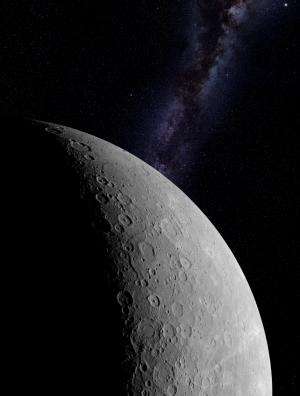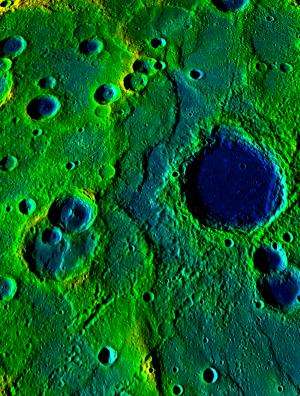Mercury contracted more than prior estimates, evidence shows

New evidence gathered by NASA's MESSENGER spacecraft at Mercury indicates the planet closest to the sun has shrunk up to 7 kilometers in radius over the past 4 billion years, much more than earlier estimates.
The new finding, published in the journal Nature Geoscience Sunday, March 16, solves an apparent enigma about Mercury's evolution.
Older images of surface features indicated that, despite cooling over its lifetime, the rocky planet had barely shrunk at all. But modeling of the planet's formation and aging could not explain that finding.
Now, Paul K. Byrne and Christian Klimczak at the Carnegie Institution of Washington have led a team that used MESSENGER's detailed images and topographic data to build a comprehensive map of tectonic features. That map suggests Mercury shrunk substantially as it cooled, as rock and metal that comprise its interior are expected to.
"With MESSENGER, we have now obtained images of the entire planet at high resolution and, crucially, at different angles to the sun that show features Mariner 10 could not in the 1970s," said Steven A. Hauck, II, a professor of planetary sciences at Case Western Reserve University and the paper's co-author.
Mariner 10, the first spacecraft sent to explore Mercury, gathered images and data over just 45% of the surface during three flybys in 1974 and 1975. MESSENGER, which launched in 2004 and was inserted into orbit in 2011, continues collecting scientific data, completing its 2,900th orbit of Mercury later this month.

Mercury's surface differs from Earth's in that its outer shell, called the lithosphere, is made up of one tectonic plate instead of multiple plates.
To help gauge how the planet may have shrunk, the researchers looked at tectonic features, called lobate scarps and wrinkle ridges, which result from interior cooling and surface compression. The features resemble long ribbons from above, ranging from 5 to more than 550 miles long.
Lobate scarps are cliffs caused by thrust faults that have broken the surface and reach up to nearly 2 miles high. Wrinkle ridges are caused by faults that don't extend as deep and tend to have lower relief. Surface materials from one side of the fault ramp up and fold over, forming a ridge. The scientists mapped a total of 5,934 of the tectonic features.
The scarps and ridges have much the same effect as a tailor making a series of tucks to take in the waist of a pair of pants.
With the new data, the researchers were able to see a greater number of these faults and estimate the shortening across broad sections of the surface and thus estimate the decrease in the planet's radius.

They estimate the planet has contracted between 4.6 and 7 kilometers in radius.
"This is significantly greater than the 1 to maybe 2 kilometers reported earlier on the basis of Mariner 10 data," Hauck said.
And, importantly, he said, models built on the main heat-producing elements in planetary interiors, as detected by MESSENGER, support contraction in the range now documented.
One striking aspect of the form and distribution of surface tectonic features on Mercury is that they are largely consistent with some early explanations about the features of Earth's surface, before the theory of plate tectonics made them obsolete—at least for Earth, Hauck said.
So far, Earth is the only planet known to have tectonic plates instead of a single, outer shell.
The findings, therefore, can provide limits and a framework to understand how planets cool—their thermal, tectonic and volcanic history. So, by looking at Mercury, scientists learn not just about planets in our solar system, but about the increasing number of rocky planets being found around other stars.
More information: Study paper: dx.doi.org/10.1038/ngeo2097
Journal information: Nature Geoscience
Provided by Case Western Reserve University




















